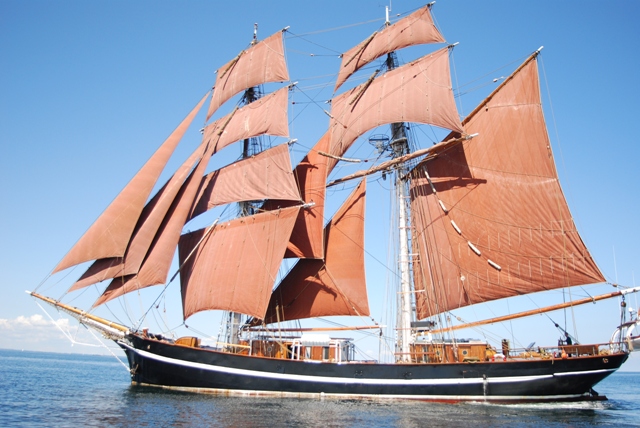|
Eye Of The Wind
''Eye of the Wind'' is a brigantine built in 1911 at the C. H. Lühring shipyard in Brake, Lower Saxony, Brake, Germany, originally as a topsail schooner named ''Friedrich''. History ''Friedrich'' was initially used as a schooner for the South American hide trade. In 1923 she was registered in Sweden, under the name ''Merry'', and was used for transport in the Baltic Sea, Baltic and North Sea, North seas and for fishing herring off the coast of Iceland during summer. In 1969, then stripped of her masts and sailing as a motor vessel, she was severely damaged in a fire that almost destroyed her. In 1973 a group of sailing enthusiasts, including Anthony "Tiger" Timbs, who later became her Master, began rebuilding her at Faversham, England. In this restoration she was re-rigged as a brigantine by Master Rigger Wally Buchanan. After the restoration was completed she was given the name ''Eye of the Wind'', inspired by Peter Scott (conservationist), Sir Peter Scott's 1961 book. In Octo ... [...More Info...] [...Related Items...] OR: [Wikipedia] [Google] [Baidu] |
Maritime Call Sign
Maritime call signs are call signs assigned as unique identifiers to ships and boats. All radio transmissions must be individually identified by the call sign. Merchant and naval vessels are assigned call signs by their national licensing authorities. History One of the earliest applications of radiotelegraph operation, long predating broadcast radio, were marine radio stations installed aboard ships at sea. In the absence of international standards, early transmitters constructed after Guglielmo Marconi's first trans-Atlantic message in 1901 were issued arbitrary two-letter calls by radio companies, alone or later preceded by a one-letter company identifier. These mimicked an earlier railroad telegraph convention where short, two-letter identifiers served as Morse code abbreviations to denote the various individual stations on the line (for instance, AX could represent Halifax). "N" and two letters would identify U.S. Navy; "M" and two letters would be a Marconi station. On A ... [...More Info...] [...Related Items...] OR: [Wikipedia] [Google] [Baidu] |
Gilleleje
Gilleleje () is a fishing town and seaside resort on the north coast of the peninsula North Zealand, Denmark. The town is located at the northernmost point of the island of Zealand. It is one of the main towns of the Gribskov municipality in Region Hovedstaden in Denmark. As of 1 January 2022, it has a population of 6,781.BY3: Population 1. January by rural and urban areas, area and population density The Mobile Statbank from Etymology The name ''Gilleleje'' is made up from the combination of the obsolete Danish[...More Info...] [...Related Items...] OR: [Wikipedia] [Google] [Baidu] |
Schooners
A schooner () is a type of sailing vessel defined by its rig: fore-and-aft rigged on all of two or more masts and, in the case of a two-masted schooner, the foremast generally being shorter than the mainmast. A common variant, the topsail schooner also has a square topsail on the foremast, to which may be added a topgallant. Differing definitions leave uncertain whether the addition of a fore course would make such a vessel a brigantine. Many schooners are gaff-rigged, but other examples include Bermuda rig and the staysail schooner. The origins of schooner rigged vessels is obscure, but there is good evidence of them from the early 17th century in paintings by Dutch marine artists. The name "schooner" first appeared in eastern North America in the early 1700s. The name may be related to a Scots word meaning to skip over water, or to skip stones. The schooner rig was used in vessels with a wide range of purposes. On a fast hull, good ability to windward was useful for priva ... [...More Info...] [...Related Items...] OR: [Wikipedia] [Google] [Baidu] |
Nova (American TV Series)
''Nova'' (stylized as ''NOVΛ'') is an American popular science television program produced by WGBH in Boston, Massachusetts, since 1974. It is broadcast on PBS in the United States, and in more than 100 other countries. The program has won many major television awards. ''Nova'' often includes interviews with scientists doing research in the subject areas covered and occasionally includes footage of a particular discovery. Some episodes have focused on the history of science. Examples of topics covered include the following: Colditz Castle, the Drake equation, elementary particles, the 1980 eruption of Mount St. Helens, Fermat's Last Theorem, the AIDS epidemic, global warming, moissanite, Project Jennifer, storm chasing, Unterseeboot 869, Vinland, Tarim mummies, and the COVID-19 pandemic. The ''Nova'' programs have been praised for their pacing, writing, and editing. Websites that accompany the segments have also won awards. Episodes History ''Nova'' was first aired ... [...More Info...] [...Related Items...] OR: [Wikipedia] [Google] [Baidu] |
Nate And Hayes
''Savage Islands'' (also known as ''Nate and Hayes'' in the United States) is a 1983 swashbuckling adventure film set in the South Pacific in the late 19th century. Directed by Ferdinand Fairfax and filmed on location in Fiji and New Zealand, it starred Tommy Lee Jones, Michael O'Keefe and Jenny Seagrove. It was one of several 1980s films designed to capitalize on the popularity of ''Indiana Jones'', but ''Savage Islands'' was a flop at the box office. Plot The film tells the story of missionary Nathaniel "Nate" Williamson, taken to an island mission with his fiancée Sophie. Their ship, the ''Rona'', is captained by the roguish William "Bully" Hayes, who also takes a liking to Sophie. When Sophie is kidnapped by slave trader Ben Pease, "Nate" teams with Hayes in order to find her. The two men enjoy a friendly rivalry for Sophie's affections, and she is to some extent torn between them, though committed to Nate. Cast * Tommy Lee Jones as Bully Hayes * Michael O'Keefe as Nathan ... [...More Info...] [...Related Items...] OR: [Wikipedia] [Google] [Baidu] |
Albatross (ship, Built In 1920)
''Albatross'', originally named ''Albatros'', later ''Alk'', was a sailing ship that became famous when she sank in 1961 with a group of American teenagers on board. The events were the basis for the highly fictionalized 1996 film ''White Squall''. Early history The ''Albatross'' was built as ''Albatros'', a schooner, at the state shipyard (Rijkswerf) in Amsterdam, Netherlands, in 1920, to serve as a pilot boat (named ''Alk'') in the North Sea. The ship spent two decades working the North Sea before being purchased by the German government in 1937. She served as a radio-station ship for submarines during the Second World War. In 1949, Royal Rotterdam Lloyd bought her for use as a training ship for future officers of their company (Dutch merchant marine). The fact that she was small made her ideal for this kind of work, and the dozen trainees could receive personal attention from the six or so professional crew. While under Dutch ownership she sailed the North Sea extensivel ... [...More Info...] [...Related Items...] OR: [Wikipedia] [Google] [Baidu] |
White Squall (film)
''White Squall'' is a 1996 American disaster survival film directed by Ridley Scott. It is a coming of age film in which a group of high school and college-aged teenagers sign up for several months of training aboard a sail ship, a brigantine, and travel around half the globe when suddenly they are challenged by a severe storm. The film stars Jeff Bridges in the role of the captain, called "Skipper", his wife, played by Caroline Goodall, and a supporting cast portraying a group of nearly a dozen student sailors. The film was based on the 1962 book ''The Last Voyage of the Albatross'' by Charles Gieg Jr. and Felix Sutton. Plot The film is based on the fate of the brigantine ''Albatross'', which sank 2 May 1961, allegedly because of a white squall. The film relates the ill-fated school sailing trip led by Dr. Christopher B. Sheldon (Jeff Bridges), whom the boys call "Skipper". He is tough and teaches them discipline. He forms a close connection with all-American Chuck Gieg ( ... [...More Info...] [...Related Items...] OR: [Wikipedia] [Google] [Baidu] |
The Blue Lagoon (1980 Film)
''The Blue Lagoon'' is a 1980 American dramatic coming-of-age romantic survival film directed by Randal Kleiser from a screenplay written by Douglas Day Stewart based on the 1908 novel of the same name by Henry De Vere Stacpoole. The film stars Brooke Shields and Christopher Atkins. The music score was composed by Basil Poledouris and the cinematography was by Néstor Almendros. The film tells the story of two young children marooned on a tropical island paradise in the South Pacific. But, without either the guidance or the restrictions of society, emotional and physical changes arise as they reach puberty, go skinny dipping in the ocean and fall in love. ''The Blue Lagoon'' was theatrically released on June 20, 1980, by Columbia Pictures and Metro-Goldwyn-Mayer. The film was panned by the critics, who disparaged its screenplay, execution, and Shields' performance; however, Almendros' cinematography received praise. In spite of the criticism, the film was a commercial succ ... [...More Info...] [...Related Items...] OR: [Wikipedia] [Google] [Baidu] |
Tai-Pan (film)
''Tai-Pan'' is a 1986 adventure drama film directed by Daryl Duke, loosely based on James Clavell's 1966 novel of the same name. While many of the same characters and plot twists are maintained, a few smaller occurrences are left out. Filmed under communist Chinese censorship, some portions of Clavell's story were considered too offensive to be filmed as written and considerable changes were made. The De Laurentiis Entertainment Group handled the production and were actively seen battling the Chinese Government and Labor boards over the film during shooting. The results fared poorly at the box office and in critical reviews. Duke believed that a mini-series à la Shōgun or Noble House would have been a far superior means of covering the complexity of Clavell's novel. Plot In 1842, the British have achieved victory of the First Opium War and seized Hong Kong. Although the island is largely uninhabited and the terrain unfriendly, it has a large port that both the British govern ... [...More Info...] [...Related Items...] OR: [Wikipedia] [Google] [Baidu] |
Brigantine
A brigantine is a two-masted sailing vessel with a fully square-rigged foremast and at least two sails on the main mast: a square topsail and a gaff sail mainsail (behind the mast). The main mast is the second and taller of the two masts. Older usages are looser; in addition to the rigorous definition above (attested from 1695), the ''Oxford English Dictionary'' has about 1525 definitions of "a small vessel equipped both for sailing and rowing, swifter and more easily manœuvred than larger ships" and "(loosely) various kinds of foreign sailing and rowing vessels, as the galleon, galliot, etc." Modern American definitions include vessels without the square sails on the main mast. Mediterranean brigantines In the Mediterranean Basin during the 13th century, a brigantine referred to a sail- and oar-driven war vessel. It was lateen rigged on two masts and had between eight and twelve oars on each side. Its speed, maneuverability, and ease of handling made it a favourite of Me ... [...More Info...] [...Related Items...] OR: [Wikipedia] [Google] [Baidu] |





